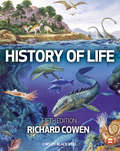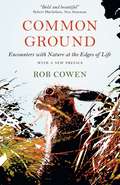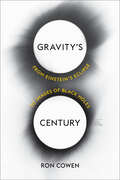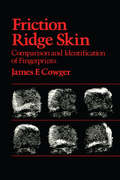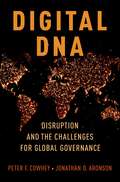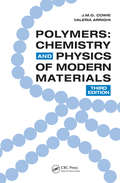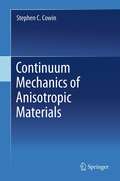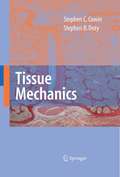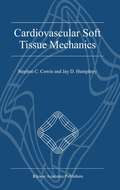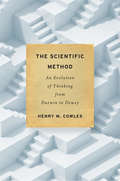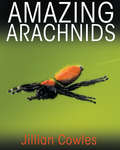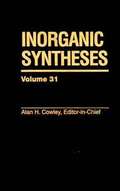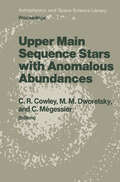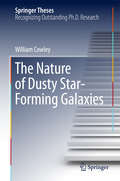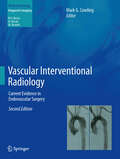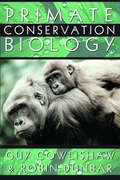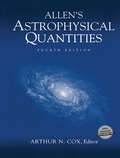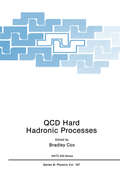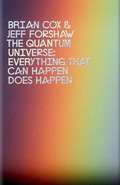- Table View
- List View
History of Life
by Richard CowenThis text is designed for students and anyone else with an interest in the history of life on our planet. The author describes the biological evolution of Earth’s organisms, and reconstructs their adaptations to the life they led, and the ecology and environment in which they functioned. On the grand scale, Earth is a constantly changing planet, continually presenting organisms with challenges. Changing geography, climate, atmosphere, oceanic and land environments set a stage in which organisms interact with their environments and one another, with evolutionary change an inevitable result. The organisms themselves in turn can change global environments: oxygen in our atmosphere is all produced by photosynthesis, for example. The interplay between a changing Earth and its evolving organisms is the underlying theme of the book. The book has a dedicated website which explores additional enriching information and discussion, and provides or points to the art for the book and many other images useful for teaching. See: www.wiley.com/go/cowen/historyoflife.
Common Ground: Encounters with Nature at the Edges of Life
by Rob CowenAll too often, we think of nature as something distinct from ourselves, something to go and see, a place that’s separate from the ordinary modern world in which we live and work. But if we take the time to look, we soon find that’s not how nature works. Even in our parceled-out, paved-over urban environs, nature is all around us; it is in us. It is us. That’s what Rob Cowen discovered after moving to a new home in northern England. After ten years in London he was suddenly adrift, searching for a sense of connection. He found himself drawn to a square-mile patch of waste ground at the edge of town. Scrappy, weed-filled, this heart-shaped tangle of land was the very definition of overlooked—a thoroughly in-between place that capitalism no longer had any use for, leaving nature to take its course. Wandering its meadows, woods, hedges, and fields, Cowen found it was also a magical, mysterious place, haunted and haunting, abandoned but wildly alive—and he fell in fascinated love. Common Ground is a true account of that place and Cowen’s transformative journey through its layers and lives, but it’s much more too. As the land’s stories intertwine with events in his own life—and he learns he is to become a father for the first time—the divisions between human and nature begin to blur and shift. The place turns out to be a mirror, revealing what we are, what we’re not and how those two things are ultimately inseparable. This is a book about discovering a new world, a forgotten world on the fringes of our daily lives, and the richness that comes from uncovering the stories and lives—animal and human—contained within. It is an unforgettable piece of nature writing, part of a brilliant tradition that stretches from Gilbert White to Robert Macfarlane and Helen Macdonald. “I am dreaming of the edge-land again,” Cowen writes. Read Common Ground, and you, too, will be dreaming of the spaces in between, and what—including us—thrives there.
Common Ground: Encounters with Nature at the Edges of Life
by Rob CowenAll too often, we think of nature as something distinct from ourselves, something to go and see, a place that’s separate from the ordinary modern world in which we live and work. But if we take the time to look, we soon find that’s not how nature works. Even in our parceled-out, paved-over urban environs, nature is all around us; it is in us. It is us. That’s what Rob Cowen discovered after moving to a new home in northern England. After ten years in London he was suddenly adrift, searching for a sense of connection. He found himself drawn to a square-mile patch of waste ground at the edge of town. Scrappy, weed-filled, this heart-shaped tangle of land was the very definition of overlooked—a thoroughly in-between place that capitalism no longer had any use for, leaving nature to take its course. Wandering its meadows, woods, hedges, and fields, Cowen found it was also a magical, mysterious place, haunted and haunting, abandoned but wildly alive—and he fell in fascinated love. Common Ground is a true account of that place and Cowen’s transformative journey through its layers and lives, but it’s much more too. As the land’s stories intertwine with events in his own life—and he learns he is to become a father for the first time—the divisions between human and nature begin to blur and shift. The place turns out to be a mirror, revealing what we are, what we’re not and how those two things are ultimately inseparable. This is a book about discovering a new world, a forgotten world on the fringes of our daily lives, and the richness that comes from uncovering the stories and lives—animal and human—contained within. It is an unforgettable piece of nature writing, part of a brilliant tradition that stretches from Gilbert White to Robert Macfarlane and Helen Macdonald. “I am dreaming of the edge-land again,” Cowen writes. Read Common Ground, and you, too, will be dreaming of the spaces in between, and what—including us—thrives there.
Common Ground: Encounters with Nature at the Edges of Life
by Rob CowenAll too often, we think of nature as something distinct from ourselves, something to go and see, a place that’s separate from the ordinary modern world in which we live and work. But if we take the time to look, we soon find that’s not how nature works. Even in our parceled-out, paved-over urban environs, nature is all around us; it is in us. It is us. That’s what Rob Cowen discovered after moving to a new home in northern England. After ten years in London he was suddenly adrift, searching for a sense of connection. He found himself drawn to a square-mile patch of waste ground at the edge of town. Scrappy, weed-filled, this heart-shaped tangle of land was the very definition of overlooked—a thoroughly in-between place that capitalism no longer had any use for, leaving nature to take its course. Wandering its meadows, woods, hedges, and fields, Cowen found it was also a magical, mysterious place, haunted and haunting, abandoned but wildly alive—and he fell in fascinated love. Common Ground is a true account of that place and Cowen’s transformative journey through its layers and lives, but it’s much more too. As the land’s stories intertwine with events in his own life—and he learns he is to become a father for the first time—the divisions between human and nature begin to blur and shift. The place turns out to be a mirror, revealing what we are, what we’re not and how those two things are ultimately inseparable. This is a book about discovering a new world, a forgotten world on the fringes of our daily lives, and the richness that comes from uncovering the stories and lives—animal and human—contained within. It is an unforgettable piece of nature writing, part of a brilliant tradition that stretches from Gilbert White to Robert Macfarlane and Helen Macdonald. “I am dreaming of the edge-land again,” Cowen writes. Read Common Ground, and you, too, will be dreaming of the spaces in between, and what—including us—thrives there.
Common Ground: Encounters with Nature at the Edges of Life
by Rob CowenAll too often, we think of nature as something distinct from ourselves, something to go and see, a place that’s separate from the ordinary modern world in which we live and work. But if we take the time to look, we soon find that’s not how nature works. Even in our parceled-out, paved-over urban environs, nature is all around us; it is in us. It is us. That’s what Rob Cowen discovered after moving to a new home in northern England. After ten years in London he was suddenly adrift, searching for a sense of connection. He found himself drawn to a square-mile patch of waste ground at the edge of town. Scrappy, weed-filled, this heart-shaped tangle of land was the very definition of overlooked—a thoroughly in-between place that capitalism no longer had any use for, leaving nature to take its course. Wandering its meadows, woods, hedges, and fields, Cowen found it was also a magical, mysterious place, haunted and haunting, abandoned but wildly alive—and he fell in fascinated love. Common Ground is a true account of that place and Cowen’s transformative journey through its layers and lives, but it’s much more too. As the land’s stories intertwine with events in his own life—and he learns he is to become a father for the first time—the divisions between human and nature begin to blur and shift. The place turns out to be a mirror, revealing what we are, what we’re not and how those two things are ultimately inseparable. This is a book about discovering a new world, a forgotten world on the fringes of our daily lives, and the richness that comes from uncovering the stories and lives—animal and human—contained within. It is an unforgettable piece of nature writing, part of a brilliant tradition that stretches from Gilbert White to Robert Macfarlane and Helen Macdonald. “I am dreaming of the edge-land again,” Cowen writes. Read Common Ground, and you, too, will be dreaming of the spaces in between, and what—including us—thrives there.
Gravity’s Century: From Einstein’s Eclipse to Images of Black Holes
by Ron CowenRon Cowen offers a sweeping account of the century of experimentation that has consistently confirmed Einstein’s general theory of relativity. He shows how we got from Eddington’s pivotal observations of the 1919 eclipse to the Event Horizon Telescope, aimed at starlight wrapping around the black hole at our galaxy’s center.
Friction Ridge Skin: Comparison and Identification of Fingerprints
by James F. CowgerHere is a complete guide to the collection, classification, and comparison of friction skin prints and the determination of identity and nonidentity. It discusses: the cause and significance of variations in prints; the importance of class characteristics in print; the application of probability in decision making; and photographic techniques and considerations.
Friction Ridge Skin: Comparison and Identification of Fingerprints (Practical Aspects Of Criminal And Forensic Investigation Ser. #Vol. 2)
by James F. CowgerHere is a complete guide to the collection, classification, and comparison of friction skin prints and the determination of identity and nonidentity. It discusses: the cause and significance of variations in prints; the importance of class characteristics in print; the application of probability in decision making; and photographic techniques and considerations.
Digital DNA: Disruption and the Challenges for Global Governance
by Peter F. Cowhey Jonathan D. AronsonInnovation in information and production technologies is creating benefits and disruption, profoundly altering how firms and markets perform. Digital DNA provides an in depth examination of the opportunities and challenges in the fast-changing global economy and lays out strategies that countries and the international community should embrace to promote robust growth while addressing the risks of this digital upheaval. Wisely guiding the transformation in innovation is a major challenge for global prosperity that affects everyone. Peter Cowhey and Jonathan Aronson demonstrate how the digital revolution is transforming the business models of high tech industries but also of traditional agricultural, manufacturing, and service sector firms. The rapidity of change combines with the uncertainty of winners and losers to create political and economic tensions over how to adapt public policies to new technological and market surprises. The logic of the policy trade-offs confronting society, and the political economy of practical decision-making is explored through three developments: The rise of Cloud Computing and trans-border data flows; international collaboration to reduce cybersecurity risks; and the consequences of different national standards of digital privacy protection. The most appropriate global strategies will recognize that a significant diversity in individual national policies is inevitable. However, because digital technologies operate across national boundaries there is also a need for a common international baseline of policy fundamentals to facilitate "quasi-convergence" of these national policies. Cowhey and Aronson's examination of these dynamic developments lead to a measured proposal for authoritative "soft rules" that requires governments to create policies that achieve certain objectives, but leaves the specific design to national discretion. These rules should embrace mechanisms to work with expert multi-stakeholder organizations to facilitate the implementation of formal agreements, enhance their political legitimacy and technical expertise, and build flexible learning into the governance regime. The result will be greater convergence of national policies and the space for the new innovation system to flourish.
Digital DNA: Disruption and the Challenges for Global Governance
by Peter F. Cowhey Jonathan D. AronsonInnovation in information and production technologies is creating benefits and disruption, profoundly altering how firms and markets perform. Digital DNA provides an in depth examination of the opportunities and challenges in the fast-changing global economy and lays out strategies that countries and the international community should embrace to promote robust growth while addressing the risks of this digital upheaval. Wisely guiding the transformation in innovation is a major challenge for global prosperity that affects everyone. Peter Cowhey and Jonathan Aronson demonstrate how the digital revolution is transforming the business models of high tech industries but also of traditional agricultural, manufacturing, and service sector firms. The rapidity of change combines with the uncertainty of winners and losers to create political and economic tensions over how to adapt public policies to new technological and market surprises. The logic of the policy trade-offs confronting society, and the political economy of practical decision-making is explored through three developments: The rise of Cloud Computing and trans-border data flows; international collaboration to reduce cybersecurity risks; and the consequences of different national standards of digital privacy protection. The most appropriate global strategies will recognize that a significant diversity in individual national policies is inevitable. However, because digital technologies operate across national boundaries there is also a need for a common international baseline of policy fundamentals to facilitate "quasi-convergence" of these national policies. Cowhey and Aronson's examination of these dynamic developments lead to a measured proposal for authoritative "soft rules" that requires governments to create policies that achieve certain objectives, but leaves the specific design to national discretion. These rules should embrace mechanisms to work with expert multi-stakeholder organizations to facilitate the implementation of formal agreements, enhance their political legitimacy and technical expertise, and build flexible learning into the governance regime. The result will be greater convergence of national policies and the space for the new innovation system to flourish.
Polymers: Chemistry and Physics of Modern Materials, Third Edition
by J. M. G. Cowie Valeria ArrighiExtensively revised and updated to keep abreast of recent advances, Polymers: Chemistry and Physics of Modern Materials, Third Edition continues to provide a broad-based, high-information text at an introductory, reader-friendly level that illustrates the multidisciplinary nature of polymer science. Adding or amending roughly 50% of the material, t
Continuum Mechanics of Anisotropic Materials
by Stephen C. CowinContinuum Mechanics of Anisotropic Materials(CMAM) presents an entirely new and unique development of material anisotropy in the context of an appropriate selection and organization of continuum mechanics topics. These features will distinguish this continuum mechanics book from other books on this subject. Textbooks on continuum mechanics are widely employed in engineering education, however, none of them deal specifically with anisotropy in materials. For the audience of Biomedical, Chemical and Civil Engineering students, these materials will be dealt with more frequently and greater accuracy in their analysis will be desired. Continuum Mechanics of Anisotropic Materials' author has been a leader in the field of developing new approaches for the understanding of anisotropic materials.
Tissue Mechanics
by Stephen C. Cowin Stephen B. DotyThe structures of living tissues are continually changing due to growth and response to the tissue environment, including the mechanical environment. Tissue Mechanics is an in-depth look at the mechanics of tissues. Tissue Mechanics describes the nature of the composite components of a tissue, the cellular processes that produce these constituents, the assembly of the constituents into a hierarchical structure, and the behavior of the tissue’s composite structure in the adaptation to its mechanical environment. Organized as a textbook for the student needing to acquire the core competencies, Tissue Mechanics will meet the demands of advanced undergraduate or graduate coursework in Biomedical Engineering, as well as, Chemical, Civil, and Mechanical Engineering. Key features:Detailed IllustrationsExample problems, including problems at the end of sectionsA separate solutions manual available for course instructorsA website (http://tissue-mechanics.com/) that has been established to provide supplemental material for the book, including downloadable additional chapters on specific tissues, downloadable PowerPoint presentations of all the book's chapters, and additional exercises and examples for the existing chapters.About the Authors: Stephen C. Cowin is a City University of New York Distinguished Professor, Departments of Biomedical and Mechanical Engineering, City College of the City University of New York and also an Adjunct Professor of Orthopaedics, at the Mt. Sinai School of Medicine in New York, New York. In 1985 he received the Society of Tulane Engineers and Lee H. Johnson Award for Teaching Excellence and a recipient of the European Society of Biomechanics Research Award in 1994. In 1999 he received the H. R. Lissner medal of the ASME for contributions to biomedical engineering. In 2004 he was elected to the National Academy of Engineering (NAE) and he also received the Maurice A. Biot medal of the American Society of Civil Engineers (ASCE).Stephen B. Doty is a Senior Scientist at Hospital for Special Surgery, New York, New York and Adjunct Professor, School of Dental and Oral Surgery, Columbia University, New York, NY. He has over 100 publications in the field of anatomy, developmental biology, and the physiology of skeletal and connective tissues. His honors include several commendations for participation in the Russian/NASA spaceflights, the Spacelab Life Science NASA spaceflights, and numerous Shuttle missions that studied the influence of spaceflight on skeletal physiology. He presently is on the scientific advisory board of the National Space Biomedical Research Institute, Houston, Texas.
Cardiovascular Soft Tissue Mechanics
by Stephen C. Cowin Jay D. HumphreyThis special volume of the Journal of Elasticity represents the first in a new p- gram dedicated to the occasional publication of collections of invited, reviewed papers of topical interest. The purpose of this program is to spotlight the dev- opments and applications in the mechanics of materials within specific areas that can enhance growth and provide insight for the advancement of the field as well as promote fundamental understanding and basic discovery. Soft Tissue Mechanics is an area of biomechanics that draws heavily upon f- damental ideas and material models from nonlinear elasticity and viscoelasticity. A major goal of this research is to understand those mechanics properties of heart, artery, collagen and skeletal muscle tissue that can be used for the diagnosis of health problems and the improvement of human life. This volume illustrates how experiment, modeling and computation is currently employed in this emerging field. May 2001 ROGER FOSDICK Editor-in-Chief Journal of Elasticity 61: ix–xii, 2000. ix Preface There are two primary areas for the application of elasticity in the biomechanics of tissues: hard tissue mechanics (e.g., bone, teeth, horns, etc.) and soft tissue - chanics (e.g., skin, tendons, arteries, etc.). The distinguishing feature between these tissue types is the amount of physiological “normal” deformation they experience. While “hard” tissues only experience small deformations, soft tissues typically experience large deformations. From a biomechanics viewpoint soft tissues fall within the realm of finite elasticity.
The Scientific Method: An Evolution of Thinking from Darwin to Dewey
by Henry M. CowlesThe surprising history of the scientific method—from an evolutionary account of thinking to a simple set of steps—and the rise of psychology in the nineteenth century. The idea of a single scientific method, shared across specialties and teachable to ten-year-olds, is just over a hundred years old. For centuries prior, science had meant a kind of knowledge, made from facts gathered through direct observation or deduced from first principles. But during the nineteenth century, science came to mean something else: a way of thinking. The Scientific Method tells the story of how this approach took hold in laboratories, the field, and eventually classrooms, where science was once taught as a natural process. Henry M. Cowles reveals the intertwined histories of evolution and experiment, from Charles Darwin’s theory of natural selection to John Dewey’s vision for science education. Darwin portrayed nature as akin to a man of science, experimenting through evolution, while his followers turned his theory onto the mind itself. Psychologists reimagined the scientific method as a problem-solving adaptation, a basic feature of cognition that had helped humans prosper. This was how Dewey and other educators taught science at the turn of the twentieth century—but their organic account was not to last. Soon, the scientific method was reimagined as a means of controlling nature, not a product of it. By shedding its roots in evolutionary theory, the scientific method came to seem far less natural, but far more powerful. This book reveals the origin of a fundamental modern concept. Once seen as a natural adaptation, the method soon became a symbol of science’s power over nature, a power that, until recently, has rarely been called into question.
Amazing Arachnids
by Jillian CowlesA richly illustrated and up-close look at the secret lives of spiders and other arachnidsThe American Southwest is home to an extraordinary diversity of arachnids, from spitting spiders that squirt silk over their prey to scorpions that court one another with kissing and dancing. Amazing Arachnids presents these enigmatic creatures as you have never seen them before. Featuring a wealth of color photos of more than 300 different kinds of arachnids from eleven taxonomic orders--both rare and common species—this stunningly illustrated book reveals the secret lives of arachnids in breathtaking detail, including never-before-seen images of their underground behavior.Amazing Arachnids covers all aspects of arachnid biology, such as anatomy, sociality, mimicry, camouflage, and venoms. You will meet bolas spiders that lure their victims with fake moth pheromones, fishing spiders that woo their mates with silk-wrapped gifts, chivalrous cellar spiders, tiny mites, and massive tarantulas, as well as many others. Along the way, you will learn why arachnids are living fossils in some respects and nimble opportunists in others, and how natural selection has perfected their sensory structures, defense mechanisms, reproductive strategies, and hunting methods.Covers more than 300 different kinds of arachnids, including ones new to scienceFeatures more than 750 stunning color photosDescribes every aspect of arachnid biology, from physiology to biogeographyIllustrates courtship and mating, birth, maternal care, hunting, and defenseIncludes first-ever photos of the underground lives of schizomids and vinegaroonsProvides the first organized guide to macroscopic mites, including photos of living mites for easy reference
Amazing Arachnids
by Jillian CowlesA richly illustrated and up-close look at the secret lives of spiders and other arachnidsThe American Southwest is home to an extraordinary diversity of arachnids, from spitting spiders that squirt silk over their prey to scorpions that court one another with kissing and dancing. Amazing Arachnids presents these enigmatic creatures as you have never seen them before. Featuring a wealth of color photos of more than 300 different kinds of arachnids from eleven taxonomic orders--both rare and common species—this stunningly illustrated book reveals the secret lives of arachnids in breathtaking detail, including never-before-seen images of their underground behavior.Amazing Arachnids covers all aspects of arachnid biology, such as anatomy, sociality, mimicry, camouflage, and venoms. You will meet bolas spiders that lure their victims with fake moth pheromones, fishing spiders that woo their mates with silk-wrapped gifts, chivalrous cellar spiders, tiny mites, and massive tarantulas, as well as many others. Along the way, you will learn why arachnids are living fossils in some respects and nimble opportunists in others, and how natural selection has perfected their sensory structures, defense mechanisms, reproductive strategies, and hunting methods.Covers more than 300 different kinds of arachnids, including ones new to scienceFeatures more than 750 stunning color photosDescribes every aspect of arachnid biology, from physiology to biogeographyIllustrates courtship and mating, birth, maternal care, hunting, and defenseIncludes first-ever photos of the underground lives of schizomids and vinegaroonsProvides the first organized guide to macroscopic mites, including photos of living mites for easy reference
Inorganic Syntheses (Inorganic Syntheses #31)
by Alan H. CowleyThe volumes in this continuing series provide a compilation of current techniques and ideas in inorganic synthetic chemistry. Includes inorganic polymer syntheses and preperation of important inorganic solidsd, sutheses used in the development of pharamacologically active inorganic compounds, small-molecule coordination complexes, and related compounds. Also contains calcuable information on transition organometallic compunds, including species with meta-metal cluster molecules. All syntheses presented here have been tested.
Upper Main Sequence Stars with Anomalous Abundances: Proceedings of the 90th Colloquium of the International Astronomical Union, held in Crimea, U.S.S.R., May 13–19, 1985 (Astrophysics and Space Science Library #125)
by C. R. Cowley M. M. Dworetsky C. MégessierThis volume contains papers presented at IAU Colloquium No. 90. at the Crimean Astrophysical Observatory in May of 1985. A few additional contributions are included from authors who for various reasons were unable to attend the meeting. Four years have passed since the last major international conference on chemically peculiar stars of the upper main sequence was held in Liege. Belgium in 1981. Previous conferences were held in 1975 (Vienna. Austria) and in 1965 (Greenbelt. Maryland. USA). As the proceedings of this Colloquium show. the recent availability of ultraviolet spectra of large numbers of normal and chemically peculiar A and B stars is having a major impact on the way we study these objects. and has led to many new. exciting and unanticipated results. Simultaneously. the more traditional study of optical spectra has been advanced through the increasing use of very high spectral resolution with high signal-to-noise detectors. The chemically peculiar (CP) stars on the upper main sequence belong in the standard framework within which we understand stellar evolution and the history of matter. Recent work has made it clear that the unusual chemistry and magnetic structure of these objects is of relevance across the broad domain of stellar astronomy. from the upper main sequence to horizontal branch stars and white dwarfs. Metal poor (J>. Boo) as well as metal rich (Ap. Am) stars are an integral part of the picture.
The Nature of Dusty Star-Forming Galaxies (Springer Theses)
by William CowleyThis thesis combines a theoretical model of galaxy formation with a treatment of the radiative transfer in the titular dusty star-forming galaxies. Embedding this within the well-established ΛCDM (Lambda cold dark matter) cosmology, the author was able to simulate galaxy populations from which realistic observational images were synthesised. Based on further analysis, he shows that there is a good correspondence with observations from new instruments such as the SCUBA2 bolometric camera and the Atacama Large Millimeter Array (ALMA) interferometer, and reveals some novel aspects of this exciting galaxy population. In particular, he shows that blending of these galaxies in the imaging produces an artificial enhancement in their clustering, which he dubs “blending bias”. This implies that the host dark matter halo masses for these galaxies have previously been significantly overestimated. He also presents amongst the first predictions from a galaxy formation model for observations of these galaxies that will be made by the James Webb Space Telescope (the successor to the Hubble Space Telescope).
Vascular Interventional Radiology: Current Evidence in Endovascular Surgery (Medical Radiology)
by Mark G. CowlingThis new edition of Vascular Interventional Radiology: Current Evidence in Endovascular Surgery provides a thorough yet succinct and accessible review of the latest knowledge in the field of endovascular surgery. All chapters have been updated to reflect the advances that have occurred during the past five years, and new chapters are included on carotid artery stenting and day case intervention. The chapter on lower limb veno-occlusive disease has been expanded to include management of deep venous thrombosis. Among the other topics considered are the endovascular treatment options in different arterial territories, aneurysm repair techniques, and the management of venous stenosis and venous insufficiency. The aim throughout is to tackle issues of evidence-based practice in order to assist trainees and experienced practitioners in making and implementing treatment decisions. This book will be an invaluable source of information for both interventional radiologists and vascular surgeons with an interest in endovascular techniques.
Primate Conservation Biology (Conservation Biology Ser.)
by Guy Cowlishaw Robin I. DunbarFrom the snub-nosed monkeys of China to the mountain gorillas of central Africa, our closest nonhuman relatives are in critical danger worldwide. A recent report, for example, warns that nearly 20 percent of the world's primates may go extinct within the next ten or twenty years. In this book Guy Cowlishaw and Robin Dunbar integrate cutting-edge theoretical advances with practical management priorities to give scientists and policymakers the tools they need to help keep these species from disappearing forever. Primate Conservation Biology begins with detailed overviews of the diversity, life history, ecology, and behavior of primates and the ways these factors influence primate abundance and distribution. Cowlishaw and Dunbar then discuss the factors that put primates at the greatest risk of extinction, especially habitat disturbance and hunting. The remaining chapters present a comprehensive review of conservation strategies and management practices, highlighting the key issues that must be addressed to protect primates for the future.
Allen’s Astrophysical Quantities
by Arthur N. CoxThis new, fourth, edition of Allen's classic Astrophysical Quantities belongs on every astronomer's bookshelf. It has been thoroughly revised and brought up to date by a team of more than ninety internationally renowned astronomers and astrophysicists. While it follows the basic format of the original, this indispensable reference has grown to more than twice the size of the earlier editions to accommodate the great strides made in astronomy and astrophysics. It includes detailed tables of the most recent data on: - General constants and units - Atoms, molecules, and spectra - Observational astronomy at all wavelengths from radio to gamma-rays, and neutrinos - Planetary astronomy: Earth, planets and satellites, and solar system small bodies - The Sun, normal stars, and stars with special characteristics - Stellar populations - Cataclysmic and symbiotic variables, supernovae - Theoretical stellar evolution - Circumstellar and interstellar material - Star clusters, galaxies, quasars, and active galactic nuclei - Clusters and groups of galaxies - Cosmology. As well as much explanatory material and extensive and up-to-date bibliographies.
QCD Hard Hadronic Processes (Nato Science Series B: #197)
by Bradley CoxThe Advanced Research Workshop on QeD Hard Hadronic Processes was held on 8-13 October 1987 at Hotel on the Cay, St. Croix, U. S. Virgin Islands. The underlying theme of the workshop, the first in a series, was an examination, both theoretical and experimental, of the state of understanding of Quantum Chromodynamics. Because of the pervasiveness of the strong interactions in all aspects of high energy physics, QCD is central to many problems in elementary particle physics. Therefore, this workshop was organized to provide a forum in which the theory Quantum Chromodynamics cou 1 d be confronted with experi ment. The workshop was organ i zed in four sessions, each of which concentrated on a major experimental arena in which a hard QCD process can be measured experimentally. A fifth session was rlevoted to global issues which effect all QCD processes. Each session began with a survey of the theoretical developments in the particular area and concluded with a round table which discussed the various information presented in the course of the discussions. A session of the workshop was devoted to the direct production of high transverse momentum photons in hadronic interactions. Data from several experiments, either completed or in progress at CERN (NA3, NA24, WA70, UA6, CCOR, R806, AFS, RllO, UA1 and UA2), were di scussed and the prospects for two new upcomi ng experi ments from Fermil ab (E-705, E-706) were presented.
The Quantum Universe: Everything that can happen does happen
by Brian Cox Jeff ForshawThe Quantum Universe brings together two authors on a brilliantly ambitious mission to show that everyone can understand the deepest questions of science. But just what is quantum physics? How does it help us understand the world? Where does it leave Newton and Einstein? And why, above all, can we be sure that the theory is good? The bizarre behaviour of the atoms and energy that make up the universe has led to some very woolly pronouncements on the nature of all interconnectedness. Here, Brian Cox and Jeff Forshaw give us the real science, and reveal the profound theories that allow for concrete, yet astonishing, predictions about the world. This is our most up-to-date picture of reality.
